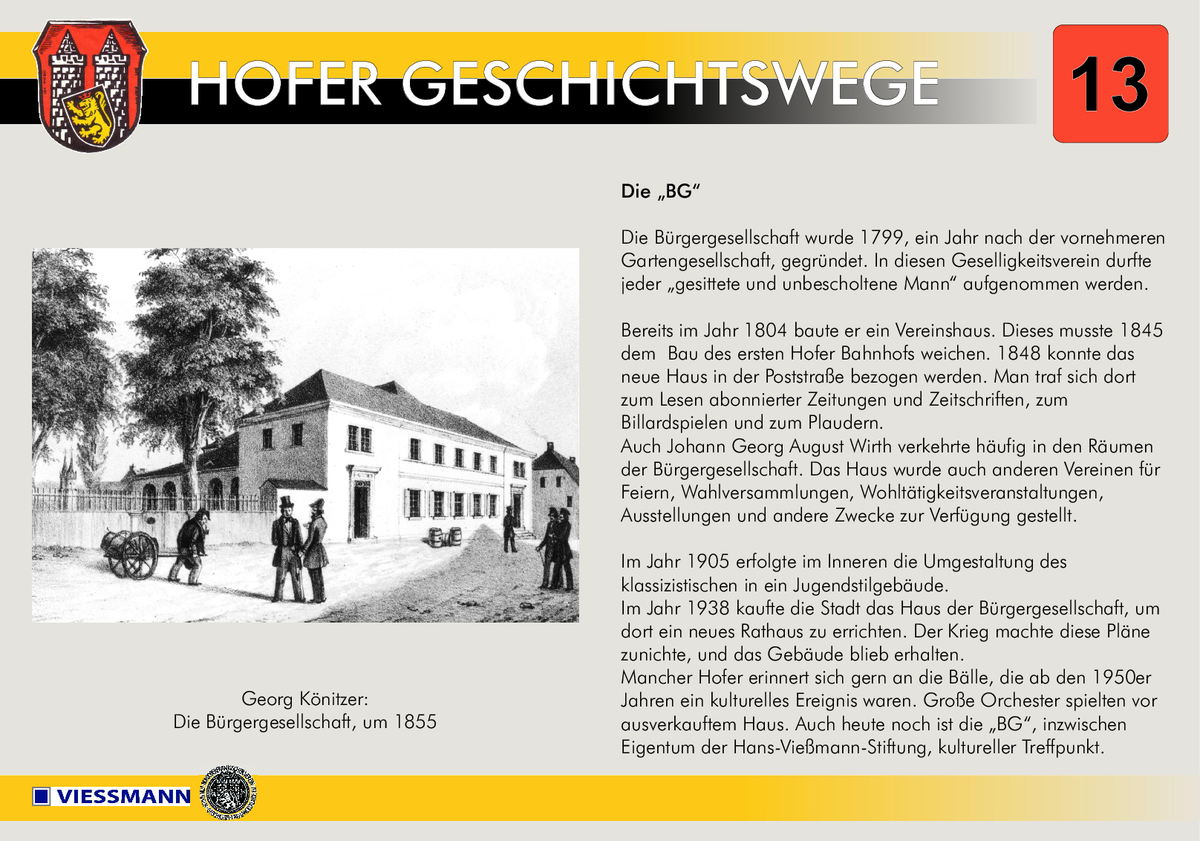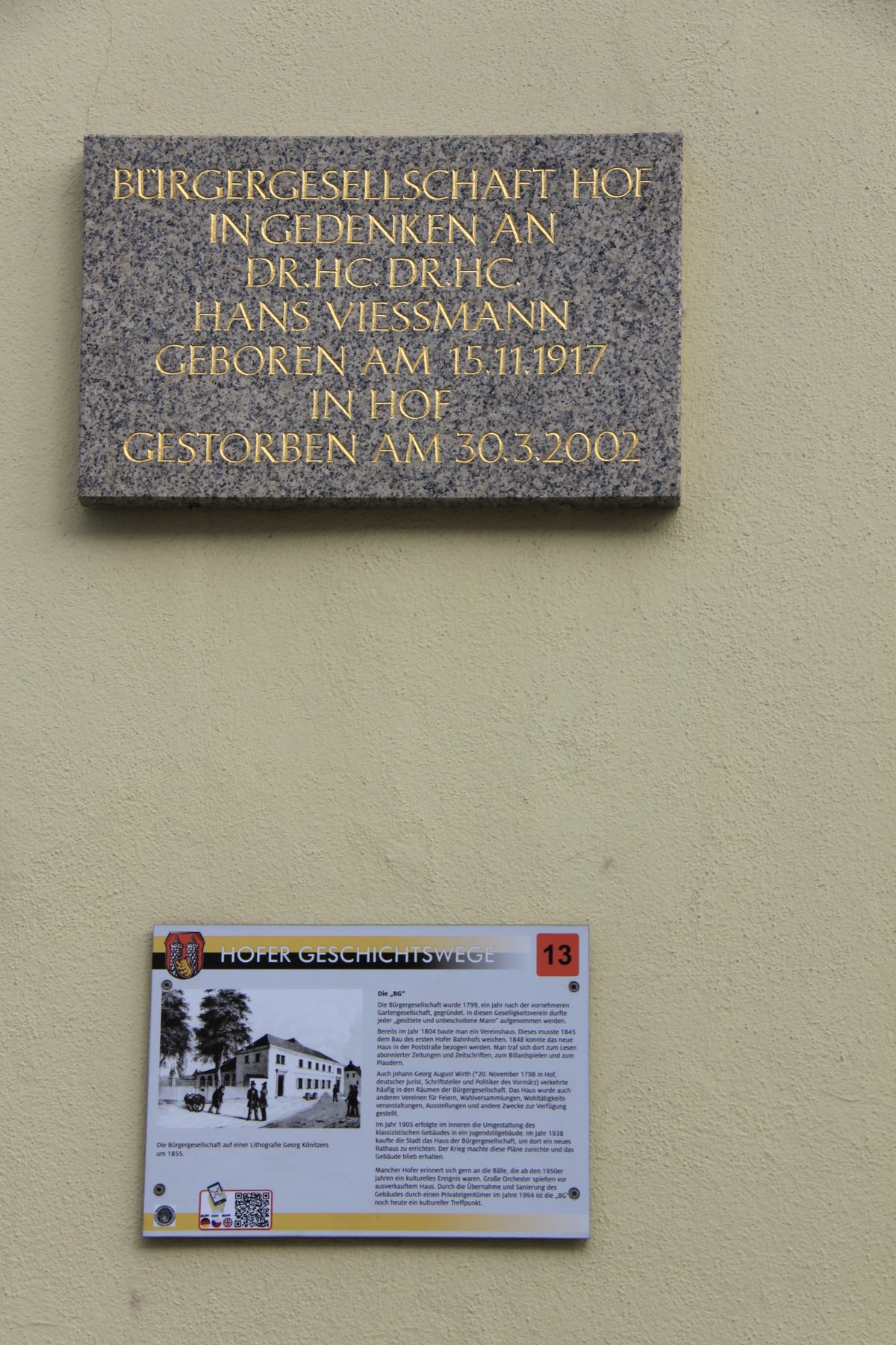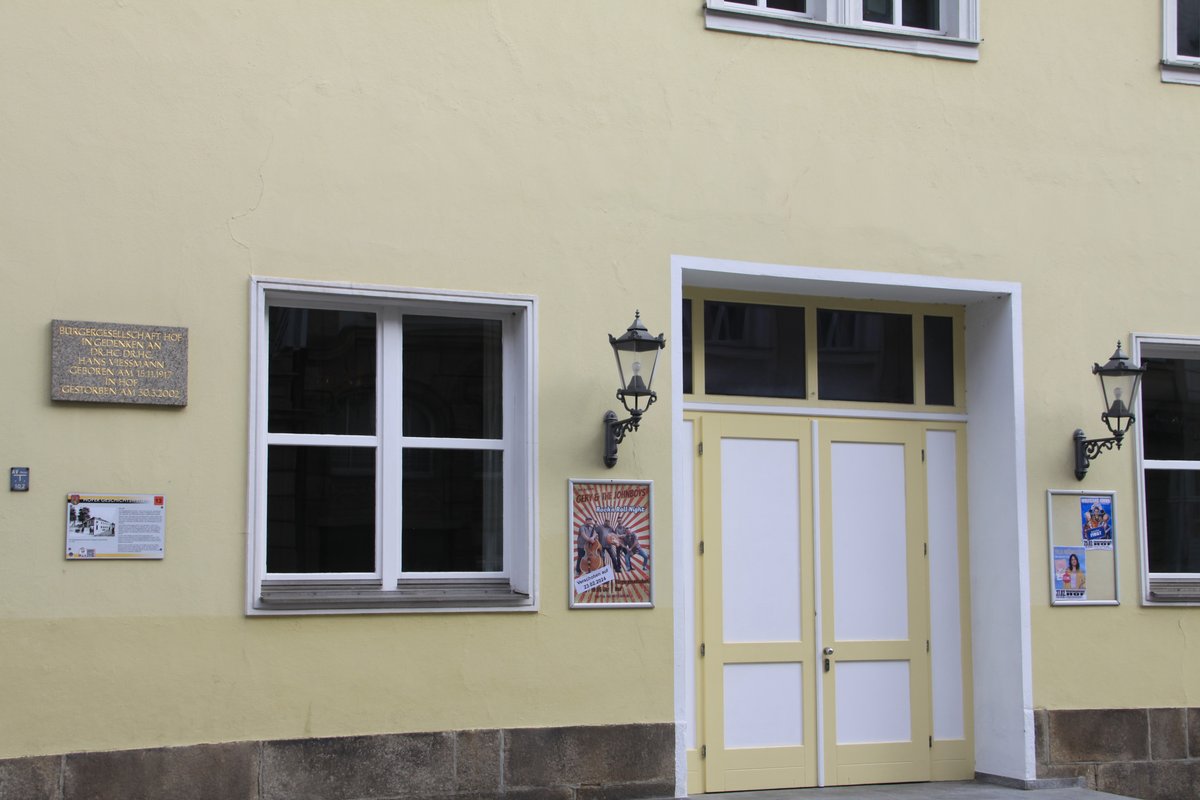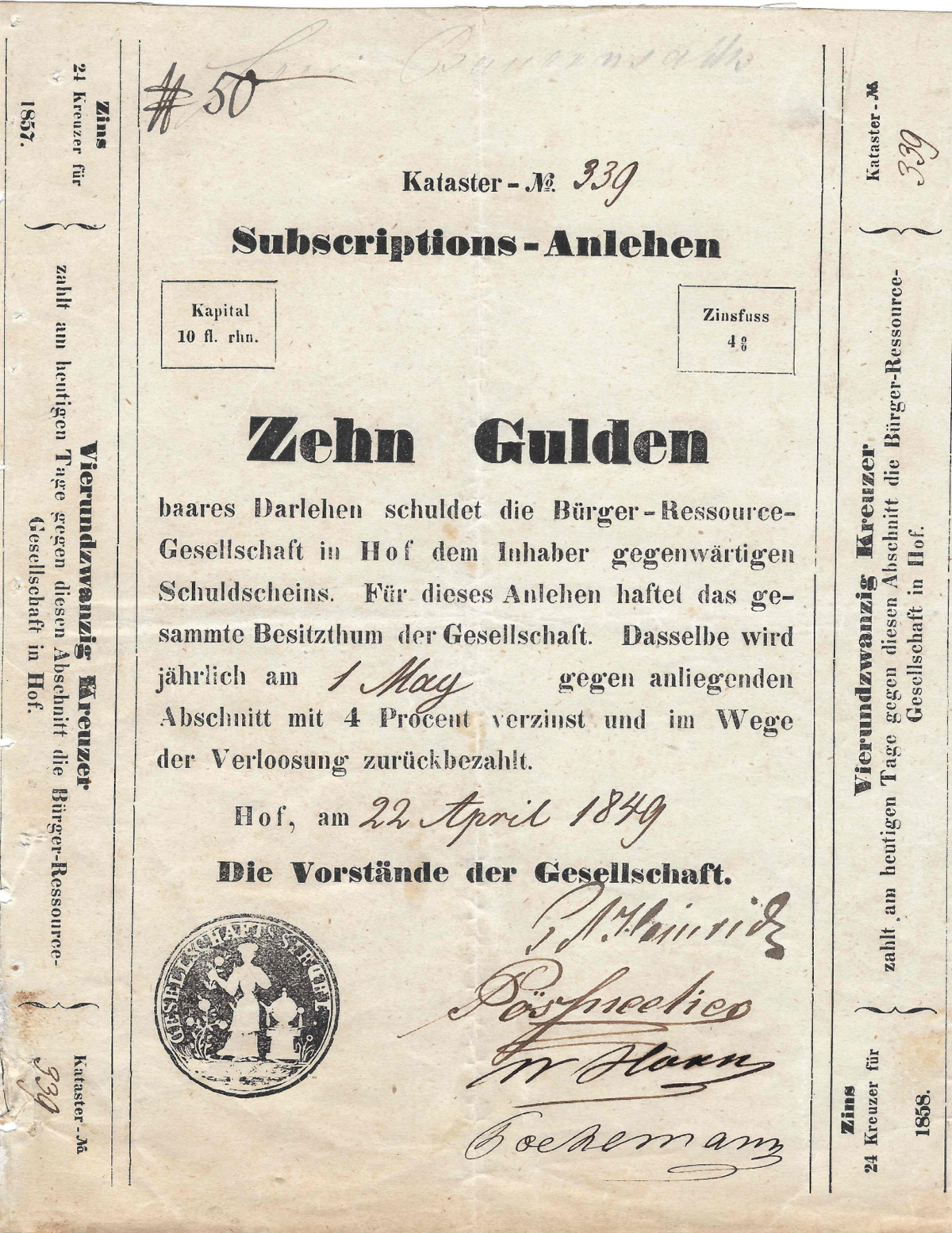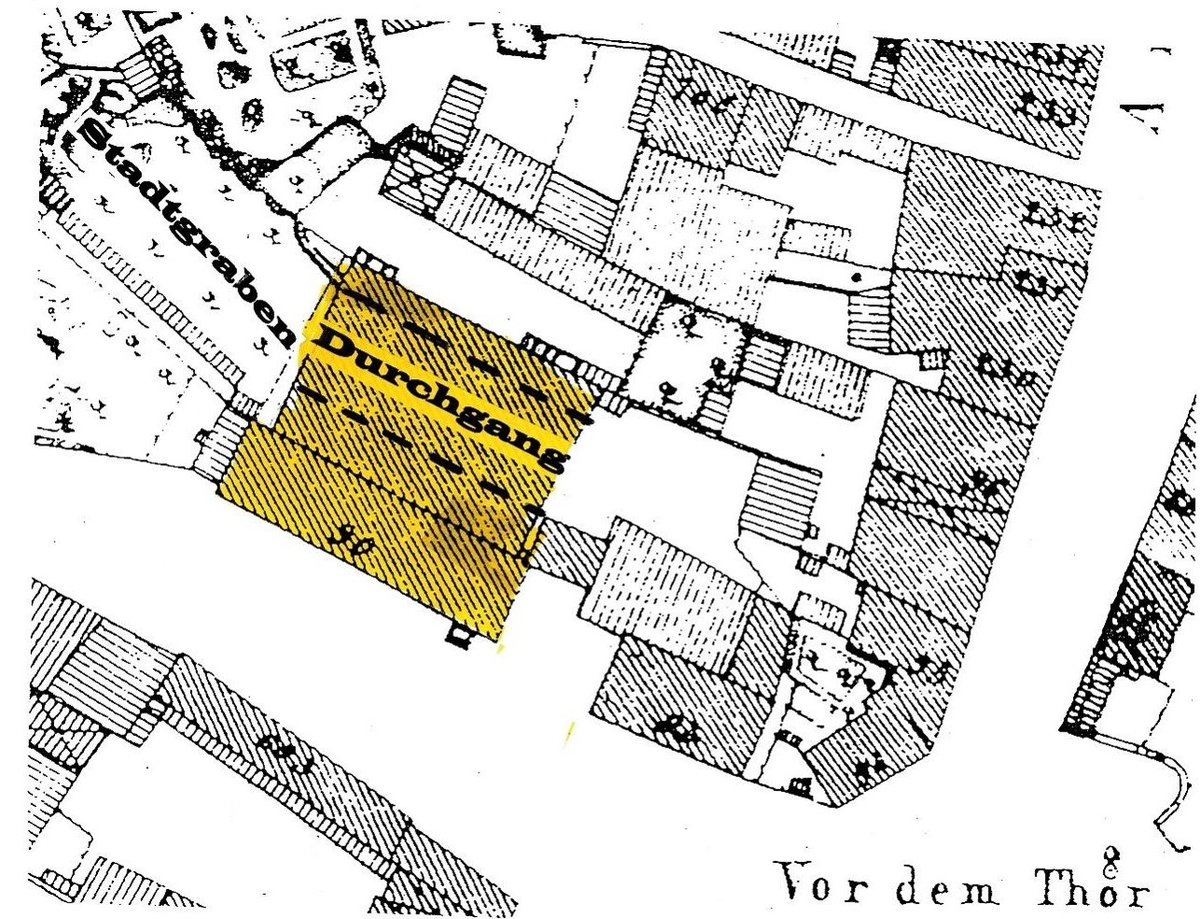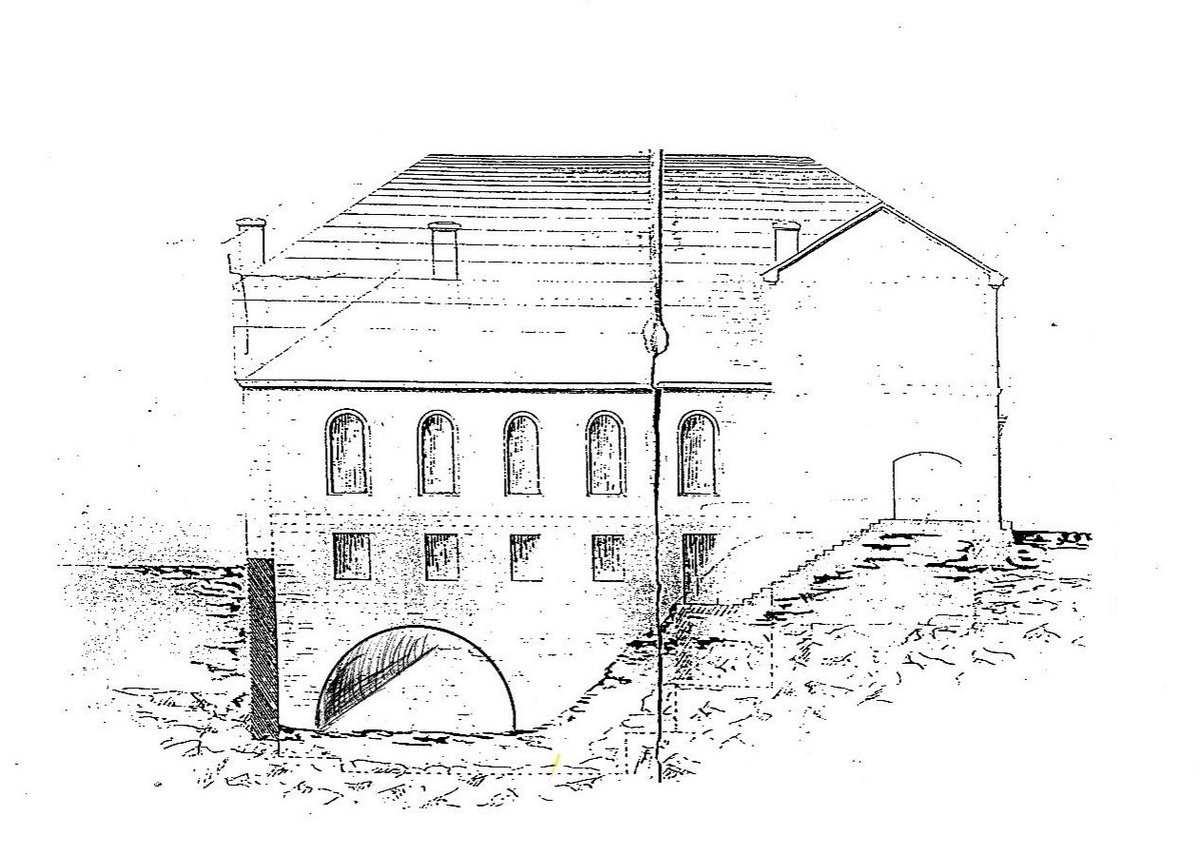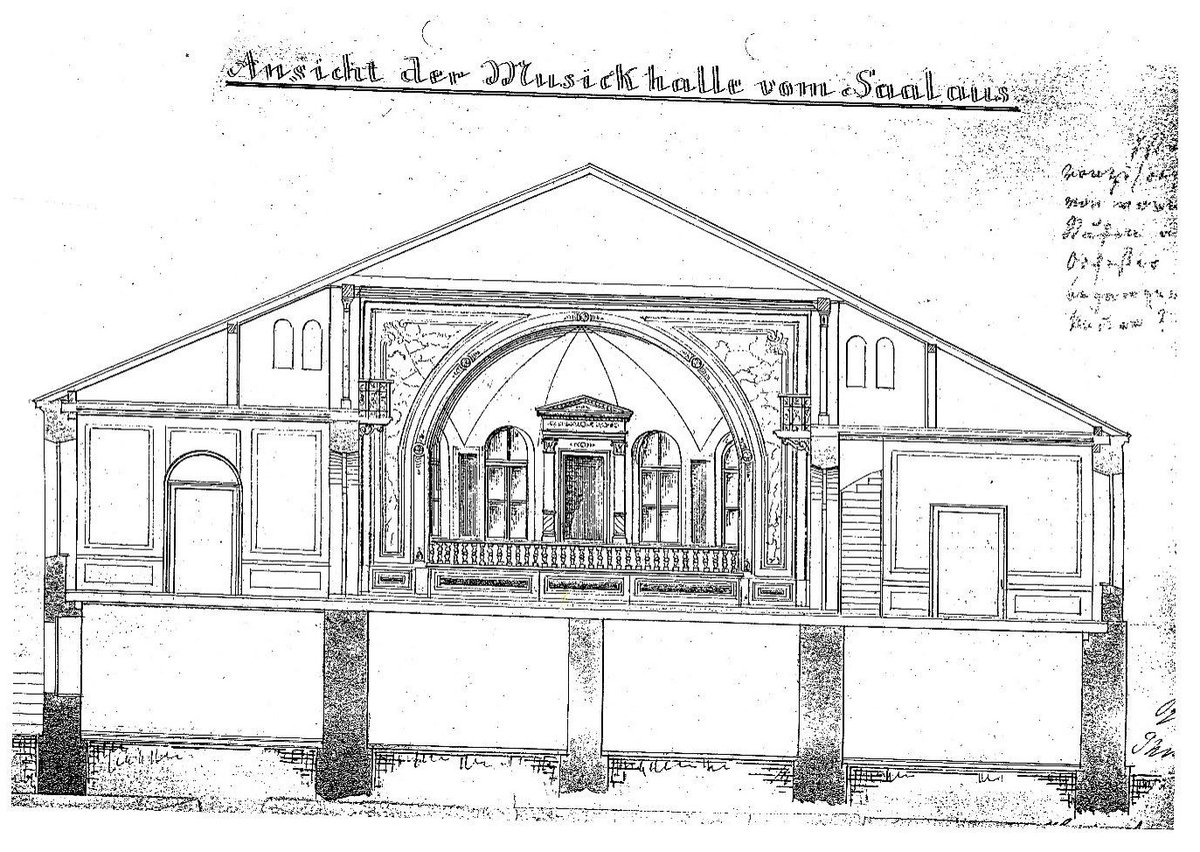Die Bürgergesellschaft
der Geselligkeitsverein des gesitteten und bescholtenen Mannes
Die Bürgergesellschaft wurde 1799, ein Jahr nach der vornehmeren Gartengesellschaft, gegründet. In diesen Geselligkeitsverein durfte jeder „gesittete und unbescholtene Mann“ aufgenommen werden. Bereits im Jahr 1804 baute er ein Vereinshaus. Dieses musste 1845 dem Bau des ersten Hofer Bahnhofs weichen. 1848 konnte das neue Haus in der Poststraße bezogen werden. Man traf sich dort zum Lesen abonnierter Zeitungen und Zeitschriften, zum Billardspielen und zum Plaudern.
Auch Johann Georg August Wirth verkehrte häufig in den Räumen der Bürgergesellschaft. Das Haus wurde auch anderen Vereinen für Feiern, Wahlversammlungen, Wohltätigkeitsveran-staltungen, Ausstellungen und andere Zwecke zur Verfügung gestellt. Im Jahr 1905 erfolgte im Inneren die Umgestaltung des klassizistischen in ein Jugendstilgebäude.
Im Jahr 1938 kaufte die Stadt das Haus der Bürgergesellschaft, um dort ein neues Rathaus zu errichten. Der Krieg machte diese Pläne zunichte, und das Gebäude blieb erhalten. Mancher Hofer erinnert sich gern an die Bälle, die ab den 1950er Jahren ein kulturelles Ereignis waren. Große Orchester spielten vor ausverkauftem Haus. Auch heute noch ist die „BG“, inzwischen Eigentum der Hans-Vießmann-Stiftung, kultureller Treffpunkt.
Georg Könitzer: Die Bürgergesellschaft, um 1855
The Bürgergesellschaft was founded in 1799, one year after the more distinguished garden society. Every "well-mannered and blameless man" was allowed to join this social club. It built a clubhouse as early as 1804. This had to make way for the construction of the first railway station in Hof in 1845. In 1848, the new house in Poststraße was occupied. People met there to read subscribed newspapers and magazines, to play billiards and to chat.
Johann Georg August Wirth also frequently frequented the rooms of the Bürgergesellschaft. The house was also made available to other associations for celebrations, election meetings, charity events, exhibitions and other purposes.
In 1905, the interior was transformed from a classical to an art nouveau building.
In 1938, the city bought the Civic Society House with the intention of building a new city hall there. The war put an end to these plans and the building was preserved.
Many a resident of Hof fondly remembers the balls that were a cultural event from the 1950s onwards. Large orchestras played to sold-out audiences. Even today, the "BG", now owned by the Hans Vießmann Foundation, is still a cultural meeting place.
Georg Könitzer: Die Bürgergesellschaft, about 1855
Občanská společnost byla založena v roce 1799, rok po založení významnější zahradní společnosti. Do tohoto společenského klubu mohl vstoupit každý "dobře vychovaný a bezúhonný muž". Již v roce 1804 si spolek postavil klubovnu. Ta musela v roce 1845 ustoupit stavbě prvního hofského nádraží. V roce 1848 byl obsazen nový dům v Poststrasse. Lidé se zde scházeli, aby si četli předplacené noviny a časopisy, hráli kulečník a povídali si.
Místnosti občanského spolku často navštěvoval také Johann Georg August Wirth. Dům byl k dispozici i dalším spolkům pro oslavy, volební schůze, dobročinné akce, výstavy a další účely.
V roce 1905 se interiér změnil z klasicistního na secesní. V roce 1938 koupilo město dům Občanské společnosti se záměrem postavit zde novou radnici. Válka tyto plány ukončila a budova byla zachována. Nejeden obyvatel Hofu s láskou vzpomíná na plesy, které byly od 50. let 20. století kulturní událostí. Velké orchestry hrály pro vyprodané hlediště. I dnes je "BG", nyní ve vlastnictví Nadace Hanse Vießmanna, stále místem kulturních setkání.
Georg Könitzer: Die Bürgergesellschaft, 1855
Die Geschichte der Bürgergesellschaft
Am 13. November 1799 wurde in Hof der Verein Bürger-Ressource ins Leben gerufen. Der ursprünglich aus elf Gründungsmitgliedern bestehende Gesellschaftsverein entwickelte sich so rasch, dass er bereits nach fünf Jahren ein eigenes Gebäude errichten konnte. Dieses hatte seinen Platz am Anfang der sogenannten „Allee“, der heutigen Lessingstraße. 1848 wurde dieses Areal von der damaligen Eisenbahn-Section zum Bau des ersten Hofer Bahnhofes benötigt. Deshalb erwarb der Bayerische Staat das Anwesen für 30.000 Gulden. Schon am 30. April 1846 fasste die Hauptversammlung des Vereins den Beschluss, ein neues Gesellschaftshaus zu erbauen; hierfür erwarb man für 2.650 Gulden den heutigen Platz in der Poststraße Nr. 6.
Wie ein Blick in die Bauakten zeigt, war der Neubau im Laufe seiner Geschichte zahlreichen Änderungen unterworfen. In der Zeit des Dritten Reiches plante der damalige Oberbürgermeister Dr. Richard Wendler sogar, an dieser Stelle ein neues Rathaus im Stil der damaligen NS-Monumentalbauten mit sieben Stockwerken zu errichten. Der Ausbruch des 2. Weltkrieges verhinderte jedoch das Vorhaben. Doch gab der Plan den Ausschlag, dass die Bürgerressource-Gesellschaft ihr Anwesen damals an die Stadt Hof verkaufte. Nach dem Krieg etablierte sich in den Räumen der Bürgergesellschaft das „Neue Theater“. Kurz vor der Währungsreform zog dieses Theater in die angestammten Räume an der Schützenstraße um.
Bis zur Übernahme durch Dr. Dr. h.c. Hans Vießmann zierte das Gebäude noch eine alte Marmortafel mit der Inschrift: „Der Freundschaft erbaut war 1804 das erste Gesellschaftshaus der Bürger-Ressource“. Sie entstammte vom ersten Haus auf dem Bahnhofsareal und wurde auf das zweite Haus mit übertragen. Leider ist diese Tafel verschollen.
Aus den Bauakten
Über den genauen Standort des um 1804 gebauten ersten Gebäudes der Bürgergesellschaft ist nur so viel bekannt, dass es im Bereich des 1848 entstandenen Bahnhofes lag. Auch die 1841 beim Magistrat eingereichten Zeichnungen zur Vergrößerung des Gebäudes sind nicht in der Bauakte enthalten. Im Zusammenhang mit der Baumaßnahme weist die kurze Beschreibung des Bestandes auf einen großen Saal und einzelne Gesellschaftszimmer hin. Ebenfalls gab es einen Hofraum mit Garten. Die Umbauten wurden vom Magistrat genehmigt und kamen zur Durchführung.
Bereits 1846 ergab sich aus der Vorplanung zum Bahnhofsgebäude, dass das erste Gesellschaftshaus im Bereich des Bauplatzes lag und nicht mehr erhalten werden konnte.
Die Verhandlungen zwischen Magistrat, Bürger-Ressource-Gesellschaft und Eisenbahnbau-Section nehmen einen großen Teil der Bauakte ein.
Der Bauplatz für den Neubau setzte sich aus mehreren käuflich erworbenen privaten Grundstücken im Bereich des Stadtgrabens „Vor dem Thor“ (gegenüber dem Gasthof „Zum Goldenen Hirschen“) und aus Gemeindeland zusammen. Es waren Flächen, die als Gras- und Gartenland genutzt wurden. Einzelne Angaben zum Umfeld des Bauplatzes (ehemaliger Pichplatz für Bierfässer mit einer Remise der Feuerwehrrequisiten) werden im Kaufvertrag benannt.
1847 wurden die Baupläne und der Situationsplan dem Magistrat erläutert und zur Genehmigung vorgelegt. Ebenfalls erfolgte die Beschreibung des Gebäudes mit der Erklärung des Nutzungskonzeptes der Bürger-Ressource-Gesellschaft. Infolge der funktionellen Verbindung zwischen Gesellschaftszimmer und großem Saal wurden zwei Haupteingänge gewählt. Links und rechts des Saales befanden sich weitere Räumlichkeiten. Eine Musiker-Empore lag im südlichen Obergeschoss des Gebäudes. Der Stadtgraben wurde überwölbt und blieb als Durchgang offen.
Eine Verzögerung der Bauangelegenheit trat durch verschiedene Bauauflagen in Verbindung mit der Freigabe durch die Eisenbahn-Section, dem Abstand zum Nachbargebäude (Gasthof „Zum Goldenen Hirschen“) und durch Eingaben der privaten angrenzenden Grundstückseigentümer ein.
Nach der Klärung aller anstehenden Auflagen begann Ende 1847 die Vorarbeit zum Bau des Gesellschaftshauses. Im Laufe des nachfolgenden Jahres wurde das Gebäude dann errichtet.
Bauphasen im Überblick
Erste Bauphase 1847/1848
Die erste Bauphase erfolgte mit kleinen Abänderungen analog der Zeichnungen von 1846. Entsprechend der Nutzung des Gebäudes und der technisch-funktionellen Veränderung wurden bereits 1861 weitere Baumaßnahmen geplant.
Zweite Bauphase 1861
Es gab in allen Stockwerken Veränderungen.
Erdgeschoss: Die Überbauung des ehemaligen Stadtgrabens wurde geschlossen.
Zweiter Stock: Im Bereich der Empore entstehen drei große Fensteröffnungen zum Saal hin
Dritte Bauphase 1864/1865
Im Bereich des östlichen und westlichen Saalbereiches werden Galerien mit Säulen eingefügt.
Vierte Bauphase 1882
Anbau einer Musikhalle
Umgestaltung der Innenausstattung mit neuer Bühnengestaltung
Neues Stuckwerk zierte nun den Saal
1906/1907
Das Dach wurde angehoben und die Galerie vergrößert.
1950
Die Fassade wurde komplett überarbeitet.
Die Übernahme durch den Fabrikanten Dr. Dr. h.c. Hans Vießmann
Im Jahre 1993 wurde die Bürgergesellschaft von dem Fabrikanten und Hofer Mäzen Dr. Dr. h.c. Hans Vießmann von der Stadt Hof aufgekauft.
Der neue Eigentümer machte Änderungen, die an dem historischen Bauwerk in der Vergangenheit vorgenommen worden waren und die störend wirkten, wieder rückgängig. So wurde der ehemalige Eingang von der Poststraße zum Saalbau wieder hergestellt.
Um dort eine Gastwirtschaft einzurichten, war auf der linken Seite ein Anbau erstellt worden, der nicht zum Stil des Gebäudes passte. Dieser ehemalige Gastwirtschaftsraum wurde nun zu einem großzügigen Foyer umgestaltet. Aus der Wohnung des Pächters im ersten Stock entstand ein kleiner Saal, ein Mehrzweckraum.
Insgesamt konnte bei diesem Umbau eine neue Treppe geschaffen werden, die das Foyer mit dem ersten Stock, aber auch mit den Sanitärräumen im Kellergeschoss und einem großen Raum, der unter dem Saalboden entstanden ist, verbindet. Unter der rechten seitlichen Empore entstand ein großer Barraum, außerdem gab es hier noch genügend Platz für eine Küche.
Das erklärte Ziel von Dr. Dr. h.c. Hans Vießmann war es, die Bürgergesellschaft zu einem Musentempel in Hof zu entwickeln.
Neben gesellschaftlichen Veranstaltungen wie Konzerten, Bällen und Tanzvergnügen sowie Kunstveranstaltungen, insbesondere für die Hofer Kunst und Kultur, war auch an eine kommerzielle Nutzung gedacht, indem z. B. Handelsunternehmen die Möglichkeit gegeben wird, Hausmessen und Ausstellungen abzuhalten.
(Dieser Text entstammt in Passagen einer Presseerklärung aus dem Jahr 1996 von Dr. Dr. h.c. Hans Vießmann)
Bildmaterial
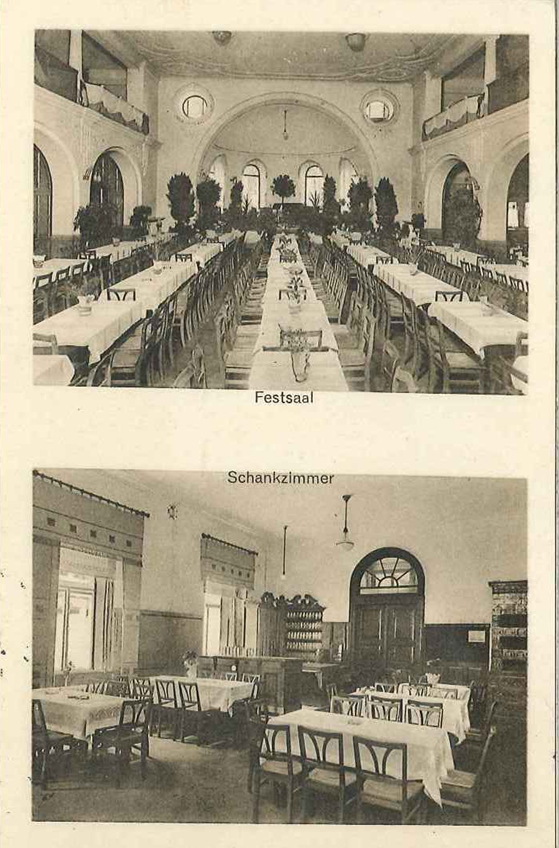
- Fundstelle: private Sammlung Dr. Dr. h.c. Hans Vießmann (Bauakten)
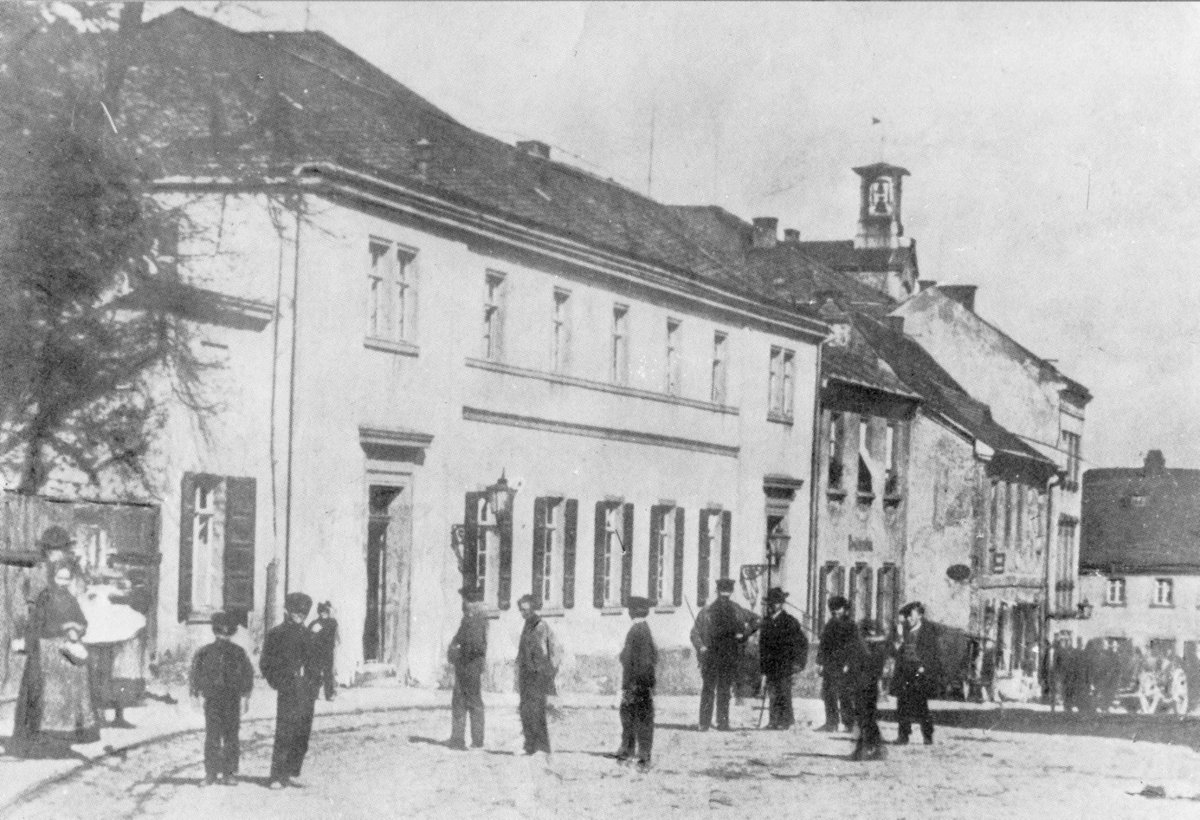
Zeit war das Dach noch nicht erhöht, die Vergrößerung der Galerie erfolgte erst in den Jahren 1906/1907. Dieses Bild hängt im Foyer der Bürgergesellschaft und entstammt der Sammlung
von Dr. Dr. h.c. Hans Vießmann
